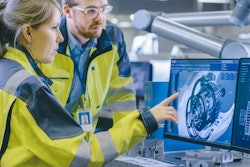
Over $250B is spent on workplace injuries every year in the US. The total global cost of illnesses, injuries, and deaths amount to 3.94% of the global GDP ($2.99 trillion). This is no small problem, it’s a workplace epidemic.
We’ve seen a lot of news recently about Amazon warehouse injury rates on the rise, and this is indicative of a larger issue at hand considering they make up a third of US warehouse employees. The rise of e-commerce over the past few years, coupled with labor shortages and increased customer demands has led to the perfect storm for distribution centers. The Industrial Athletes who operate these facilities face a higher volume of orders and are incentivized to work longer and harder, while receiving less training. It’s no surprise they are getting hurt.
With increased awareness, many companies are beginning to make investments to improve working conditions in the warehouse, yet injuries remain on the rise. The fact is, without in-depth insights into what’s actually going on in the warehouse and on the floor, it’s impossible to identify and address the underlying sources of injury. By collecting accurate data to get better visibility into the supply chain, organizations can assess all of the contributing factors to injury and make the necessary adjustments.
Data or not, solving this issue remains dependent on a top down commitment to safety culture. Investing in new equipment or creating goals to reduce injuries is not enough – leaders and management must practice what they preach.
Current practices are outdated
Too often we find companies relying on outdated, subjective methods when it comes to how they collect and file data on workplace injuries. Filing reports through an OSHA 300 log is subject to opinion, and human errors can lead to an inaccurate assessment. Future reports, for insurance purposes or other documentation, rely on this incorrect data and often are pulled from up to 12 months back – rendering them outdated as well. Proactive risk assessments face the same flaws, as these rely on subjective observations, and there's an industry observatory bias rate close to 30%.
Instead of relying on subjective means, technology can be used to collect data more accurately by implementing IoT and warehouse management systems. Using 3PL’s can make operations siloed and disconnected and many still rely on antiquated technology. By leveraging smart IoT solutions, facilities benefit from first party, interconnected data that can feed directly into HR platforms, injury reporting systems, time clock management software and more.
Analyzing warehouse data serves as a critical indicator of the source of on floor issues. For example, if new hires are getting injured at a higher rate it likely means they did not get sufficient safety training, or it can uncover insights on unsafe areas that have higher frequency of strains/musculoskeletal injuries, falls and more.
Improve human operations
Across the industry new hires are being thrown onto the floor too quickly without receiving proper training. The latest figures from the Bureau of Labor Statistics put annual warehouse turnover rates at 43%. Of this number, 60% of turnover happens in the first 90 days. New hires are more prone to getting hurt on the job or they end up burning themselves out quickly, which more training could help reduce.
Pick incentives are a great example to demonstrate where data can be used to effectively evaluate worker performance and inform adjustments aimed at preventing injuries. Setting pick incentives too high or encouraging Industrial Athletes to pick up extreme amounts of extra workload leads to overexertion and more frequent injuries. So much, in fact, that the costs of these injuries frequently end up exceeding the value of the extra labor the worker carried out. Having access to this data can show managers that at a certain threshold the output flattens or curves down – an indication that workers are overexerted and more prone to injury. Knowing this, leaders can pinpoint ideal incentive rates and preventatively ensure their employees do not burn out.
Using solutions like wearable tech can provide data on an individual level, which can alert facility workers when they are getting too close to a dangerous area or when they are lifting incorrectly, or even pick up on an exposure to harmful substances. This is effective for not only reducing specific injuries, but it promotes a better mental health environment.
Employees, especially seasonal or temp hires, are often hesitant to report injuries out of fear they will be punished in some way for doing so. It’s up to line managers to preach a safety culture that encourages proper and accurate reporting and prioritizes processes that reduce injury. Even a simple stretch and flex before every shift can make a huge difference. During the pandemic many organizations stopped the pre-shift group stretches, but now is the time to start integrating them back in.
Using automation and infrastructure correctly
Businesses are exploring new distribution center robotics that can reduce the mass of picking and packing responsibilities that fall on human shoulders. But, they do not take into consideration the physiology and well-being of how that automated process affects the altered role of the human job. Many times, they actually increase injury rates rather than optimize the process.
Automating a process like line picking drastically changes a warehouse worker's role. The humans on the floor sorting packages are no longer walking around stretching their legs, they are instead doing singular repetitive motions, and are getting more frequent musculoskeletal injuries.
Data can also reveal flaws in infrastructure or current equipment. If there are multiple areas in the facility that the data reveals have an unusually high injury rate that persists, the fix may require more than changing a process, it may be a structural issue. Companies need to have these insights available to pick up on whether something as simple as adding in a conveyor belt with a bend in it could reduce the frequency of injuries that occur in that area of the supply chain.
Tackling the workplace epidemic and instilling a true safety culture requires implementing technology to gather data to develop a better understanding of your workers and their environment. The impact can be profound. Investing in workplace safety often leads to a healthier and happier workforce, which in turn can positively affect productivity and morale.


















